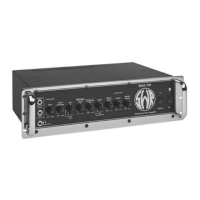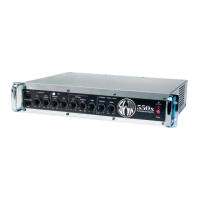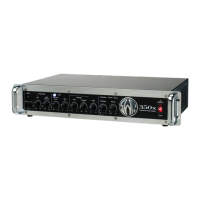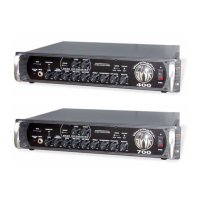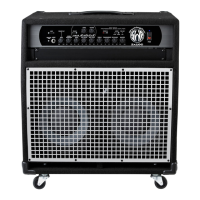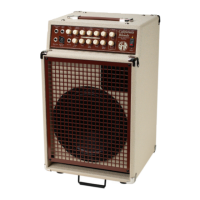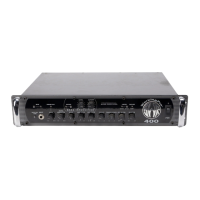Turning On The Unit
Remove the AC cable from the accessory pack and connect it from the amplifier to a standard wall outlet. Make sure that
the Pre-Amp Volume and both Master Volume controls are set to the minimum position. Locate the power switch on the right
side of the front panel and turn the amplifier on. The power switch should then illuminate in red. Upon powering up, don't be
surprised if you hear a small pop. This is absolutely normal. (Eliminating this "power on transient" would require a compo-
nent called a relay. SWR chose not to incorporate this type of component due to the fact that relays degrade signal quality
and often fail, causing the unit to have no output and requiring a trip to a local service center.) Also, the preamp tube will
take approximately 7-10 seconds to warm up before producing signal. This too is normal.
Getting Sound Out Of The Mo' Bass
Plug your instrument into the desired input jack (please refer to "Front Panel Feature Definitions" for more detail). Turn your
instrument's volume up to at least 75% of maximum and slowly adjust the Pre-Amp Volume control. The green LED over the
Pre-Amp Volume control should illuminate every time you play. Keep playing and turning the Pre-Amp Volume control up
until you see the green LED turn red. Then back off on the Pre-Amp Volume about two numbers on the dial. Now turn up
the Master Volume controls to an equal level. You should now hear the sound of your instrument amplified through
the Mo' Bass into your speaker cabinets and the stereo headphones jack. For more detailed information, please read the
entire manual carefully, as the Mo' Bass is an extremely dynamically sensitive unit and the concept of "gain structure" is very
important and will be discussed in great detail.
FRONT PANEL FEATURES
Input Jacks
Both input jacks accept a standard 1/4" phone plug and both inputs can be used at the same time. Since the two inputs are
totally independent, no loss in volume or tone will occur by using two instruments simultaneously. However, the main
applicational use for the two separate input jacks is their difference in level, as the Passive/Active input has five times more
gain than the Active input. In other words, it's not necessarily intended as a "submixer" for two instruments, but no harm will
come from having two instruments plugged in at once. Please read below for more details.
A Word About Gain Stages
One of the most important concepts to keep in mind when using the Mo' Bass is what we mean by "gain stages." Think of
dominoes - when they're lined up in a row, the first one to fall will affect everything behind it. That's how a signal path works,
and everything added along the way contributes to the overall "gain." If the very beginning of the signal path is loaded up
with too much gain, everything behind might not behave the way you might like.
Some people like to use certain effects - especially foot pedals - in front of their amplifier. In the case of the Mo' Bass, it's
important that any pedal have an output close to unity gain in relation to its input. In other words, any pedal that might add a
lot of gain to the signal may be better off in the effects loop than in front of the amplifier.
A signal path will have several "gain stages" in the internal circuitry of the preamp and power amp alone, even before you
start adding effects. Just remember that every time you change something in the signal path, most likely a level will change.
That altered level will then feed the next part of the chain with more or less input signal, which in turn will multiply every time
the level increases or decreases due to an effect being engaged. And so on, and so on, and so on...
Passive/Active Input Jack
This jack is designed for use with both passive and active instruments. A "passive" instrument (like a standard Jazz bass)
has no built-in preamp and does not use a battery. On the other hand, an "active" bass utilizes a battery-operated preamp
either for gain, tone controls, or both. Although labeled "passive," the Passive/Active input jack will work with all instruments
having a maximum output of less than 1 volt RMS. Some pickups such as EMG, Bartolini, etc. employ batteries for operation
and will work perfectly using the Passive/Active input jack. Instruments from MTD, Pedulla, Sadowsky, Lakland, Ernie Ball,
Tobias, Modulus Graphite, etc.generally contain active electronics and could also be used in the Passive/Active input.
Just because you have an active bass doesn't mean that you have to use the Active input! Generally speaking, try the
Passive/Active input jack first. If you hear a small amount of distortion and the Pre-Amp Volume clip LED is not turning
red, try using the Active input jack.
2
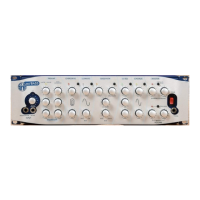
